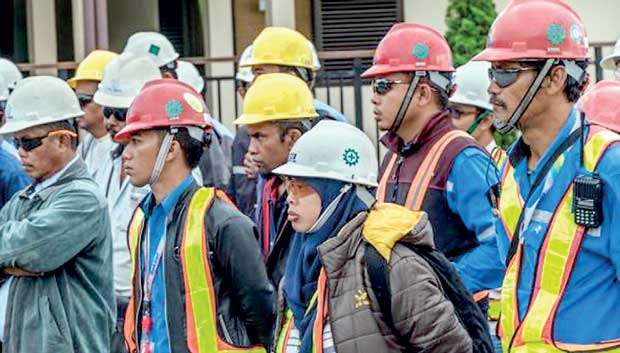Reply To:
Name - Reply Comment
Last Updated : 2024-04-20 00:00:00

 Asia and the Pacific has enjoyed robust economic growth and experienced large reductions in poverty in the past few decades. Nevertheless, with the region home to 1.2 billion people living on less than US $ 1.9 per day (in 2011 PPPs), the international poverty line for extreme poverty, poverty reduction remains a key challenge.
Asia and the Pacific has enjoyed robust economic growth and experienced large reductions in poverty in the past few decades. Nevertheless, with the region home to 1.2 billion people living on less than US $ 1.9 per day (in 2011 PPPs), the international poverty line for extreme poverty, poverty reduction remains a key challenge.
How can these people break the cycle of poverty and improve their standard of living? A significant part of the answer is contingent on the wages that workers—especially the less educated—are able to make in sectors that employ large numbers of people.
For example, although earnings are often very high in the utilities sector, the sector typically employs only about 0.3 percent-2 percent of workers. Agriculture, on the other hand, accounts for at least 30 percent of employment in many low- and middle-income countries but wages are often insufficient to keep workers and their families out of poverty.
Let’s assess the wages of workers in the three largest employers by sector in developing Asia: manufacturing, trade services and agriculture. Significantly, these sectors are the ones that generate the biggest employment opportunities for the region’s less educated.
Employment shares by country range between 15 percent-65 percent for agriculture, 8 percent-18 percent for manufacturing and 11 percent-22 percent for trade services for seven countries whose data we analysed (India, Nepal, Pakistan, the Philippines, Sri Lanka, Thailand and Viet Nam). The shares of workers with primary education or less are also quite large across all three sectors: 52 percent-81 percent in agriculture, 17 percent-59 percent in manufacturing and 16 percent-47 percent in trade services.
When evaluating wages, we look at whether workers are earning at least a so-called ‘living wage’. This refers to a benchmark wage level needed by a worker to support his/her family’s basic expenses such as shelter, food and other necessities – one that is sufficient to keep a worker’s family out of poverty.
We estimate developing Asia’s living wage at US $ 254.28 per month (in 2011 PPPs). This is enough for one worker to support a family of four.
To obtain the above figure, we inflated the poverty line figure for a family of four of US $ 7.6 per day by 10 percent to make room for discretionary spending and assumed that the maximum number of work days per month and work hours per week is 21.5 and 48, respectively. We then compared this living wage against the actual earnings of workers in India, Nepal, Pakistan, the Philippines, Sri Lanka, Thailand and Viet Nam, taking into account spatial price differences across regions, states and provinces.
Our estimates show that 87 percent of workers in Thailand are earning at least the living wage rate. In Viet Nam and Sri Lanka it is 71 percent and 56 percent, respectively.
However, less than half of workers in India, Nepal, Pakistan and the Philippines reach the living wage rate. So, how can workers’ wages in these countries be improved?
The experience of East Asia’s ‘Tiger economies’ is often cited to illustrate how rapid inter-sectoral reallocations of labour from agricultural employment to non-agricultural employment, especially in the manufacturing sector, can foster growth and better living standards.
Indeed, the shares of living wage earners among non-agricultural workers in India and Nepal are approximately 20 percentage points higher than the national average. As such, it has been suggested that to improve workers’ welfare, more employment must shift to more productive and higher-paying sectors such as manufacturing.
The pattern is clear when looking into these three sectors. Not surprisingly, the manufacturing sector does well in terms of ensuring that its workers are earning living wages. Agriculture, on the other hand, does not, except in Thailand and Viet Nam, where agriculture workers are earning more, on average, than the other countries we studied here.
What is most interesting to note—and seems to be underappreciated—is that the trade services sector does nearly as well as manufacturing in paying workers a living wage rate or higher.
Given that manufacturing and trade services largely employ relatively low-educated workers, both are good options for agricultural workers wishing to transition to better-paying sectors. Also, in economies where it’s harder to find new manufacturing jobs, like the Philippines where manufacturing employment accounts for only around 8 percent of the workforce (in contrast to, say China, which at a comparable level of gross domestic product per capita had 16 percent of employment in manufacturing), trade services are a viable alternative to keep workers out of poverty.
At the same time, even as workers continue to leave agriculture, it will likely remain the single largest employer in many economies of developing Asia for some time. For example, assuming that employment shares in agriculture decline at the same rate as they did over 2000–2015, the sector is expected to employ in 2030, 34 percent of the workforce in Pakistan and 29 percent in India.
Thus, while helping the region’s lower-skilled workers transition to manufacturing, trade services and other non-agricultural sectors must be an important component of poverty reduction strategies, equally important is increasing the productivity of workers who remain in it.
Doing so will be crucial for enabling developing Asia’s poorest break out of poverty and foster more inclusive and sustainable growth.
(Arturo Martinez is a Statistician, Economic Research and Regional Cooperation Department of the Asian Development Bank while Rhea Molato Gayares and Mia Kim Maceda Veloso are Research Associates at the same department)

Add comment
Comments will be edited (grammar, spelling and slang) and authorized at the discretion of Daily Mirror online. The website also has the right not to publish selected comments.
Reply To:
Name - Reply Comment
On March 26, a couple arriving from Thailand was arrested with 88 live animal
According to villagers from Naula-Moragolla out of 105 families 80 can afford
Is the situation in Sri Lanka so grim that locals harbour hope that they coul
A recent post on social media revealed that three purple-faced langurs near t